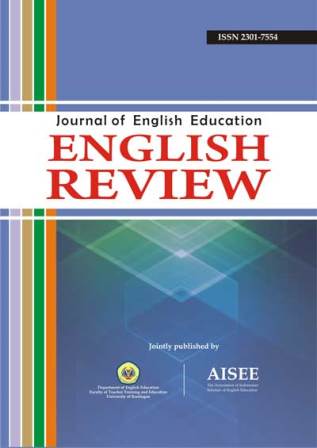JOURNAL INFORMATION
2025-03-07
Since its establishment in 2011, English Review: Journal of English Education (ERJEE) has welcomed contributions from authors representing various countries, including United States of America, Australia, Russia, Spain, Croatia, Turkey, Japan, China, Hong Kong, Malaysia, Thailand, Philippines, India, Pakistan, Saudi Arabia, Yemen, Sudan, Libya, Sri Langka, Nigeria, and Palestine. The diversity of its authors reflects the journal’s international recognition and its role in facilitating cross-cultural academic discourse. Furthermore, the reviewers and editors of ERJEE are also from various countries, ensuring a high standard of peer review and a multidimensional perspective on English education research. This global collaboration strengthens the journal’s academic integrity and broadens the scope of its research contributions.
The visitor statistics from the Flag Counter image highlight the global reach and impact of the ERJEE. With a total of 858,018 page views (March 7th, 2025) the journal has attracted significant traffic over time, demonstrating strong engagement from readers worldwide. This high number of page views suggests that the journal is a widely accessed resource for research and discussions related to English language education. The data also reflects the journal’s growing recognition within academic communities, particularly among educators, researchers, and students.
A closer look at the visitor distribution reveals that Indonesia (ID) leads with 175,582 visitors, which is expected since the journal originates from Universitas Kuningan, Indonesia. This strong domestic readership suggests that ERJEE plays a crucial role in supporting English language education and research within the country. Other top contributing countries include the Philippines (27,062), the United States (24,265), Malaysia (10,071), and the United Kingdom (7,822). These figures indicate a broad international audience, particularly in Southeast Asia, North America, and Europe, where English education and linguistics research are highly relevant. The journal's ability to attract readers from these regions highlights its credibility and relevance in global academic discussions.
Beyond these leading countries, the data shows that ERJEE has visitors from over 200 countries, as indicated by the "Flags Collected" count. The readership spans multiple continents, including Europe (Germany, France, UK, Russia), Africa (South Africa, Nigeria, Tanzania), and Asia (China, India, Pakistan, Thailand). This extensive international reach suggests that ERJEE is not only a national publication but also a globally recognized platform for knowledge exchange in English language education. Moreover, the presence of visitors from countries with strong academic and educational institutions—such as the United States, the United Kingdom, Australia, and Canada—further reinforces the journal’s impact on global English language teaching research.
The high page views and widespread audience demonstrate that ERJEE is a valuable academic resource for professionals in the field of English language education. Its influence is particularly evident in countries where English is either a primary or a second language. To further expand its global reach, ERJEE can implement SEO strategies, open-access initiatives, and international collaborations. Enhancing its visibility through indexing in Scopus, Web of Science, or DOAJ could attract even more researchers and educators. Additionally, forming partnerships with universities and research institutions worldwide could further establish ERJEE as a leading journal in English language education.





